- Home
- Shelby Foote
The Civil War: A Narrative: Volume 2: Fredericksburg to Meridian Page 6
The Civil War: A Narrative: Volume 2: Fredericksburg to Meridian Read online
Page 6
“They are massing very heavily and will break your line, I am afraid,” Lee told Longstreet. But Old Peter did not believe it. He was ready for the whole Yankee nation, provided it would come at him from the direction this portion of it had done three times already, and he said so: “General, if you put every man now on the other side of the Potomac in that field to approach me over that same line, and give me plenty of ammunition, I will kill them all before they reach my line. Look to your right; you are in some danger there,” he said. “But not on my line.”
It was true; Lee’s line was in considerable danger southward. While Sumner’s men were charging the sunken road, repeatedly and headlong, taking their losses, Franklin was taking stock of the situation as Pelham’s brass Napoleon and Jackson’s masked batteries had left it when they disrupted his first and second advances. Both had been tentative, at best, but now he believed he knew what he had to deal with. However, as in Pleasant Valley preceding the battle on Antietam Creek, he was inclined to be circumspect: an inclination which had not been lessened here on the Rappahannock by Burnside’s instructions that, once he was over the river “with a view to taking the heights,” he was to be “governed by circumstances as to the extent of your movements.” Further instructions had arrived this morning, warning him to keep his attack column “well supported and its line of retreat open.” Accordingly, before going forward for the third time, he took care to protect the flank in Stuart’s direction. The attack was delivered by the same corps, commanded by Major General John F. Reynolds, whose three divisions were under Major General George G. Meade and Brigadier Generals Abner Doubleday and John Gibbon. Doubleday was ordered to wheel left, guarding the bruised flank (sure enough, Pelham came out promptly and began to pound him) while the other two went forward in an attempt to storm the ridge. Gibbon, on the right, got as far as the railroad embankment, where he ran into murderous point-blank fire, was himself wounded, and had to be brought out on a stretcher. He was followed shortly by his men, who were not long in discovering that the Johnnies had drawn them into a trap.
That left Meade, whose division was the smallest of the three. Out of 60,000 soldiers available for the intended assault on the Confederate right, Franklin managed to get only these 4500 Pennsylvanians into slugging contact with the enemy, but they did what they could to make up in spirit for what they lacked in weight. Charging first to the railroad, then beyond it, they struck a boggy stretch of ground, about 500 yards in width, which A. P. Hill had left unmanned in the belief that it was impenetrable. It was not. Meade’s troops slogged through it, burst upon and scattered a second-line brigade of startled rebels, and were still driving hard toward the accomplishment of Franklin’s assignment—that is, to get astride the lower ridge and then sweep northward along it, dislodging men and guns as he went—when they themselves were struck in front and on both flanks by a horde of screaming graybacks.
These were Early’s men, from over on the right. Told that Hill’s line had been pierced, they came on the run, hooting as they passed the fugitives: “Here comes old Jubal! Let old Jubal straighten out that fence!” Then they struck. The Pennsylvanians were driven back through the boggy gap and out again across the open fields, where the pursuers stabbed vengefully at their rear and Confederate guns to the left and right tore viciously at their flanks. Unsupported, heavily outnumbered, thrown off balance by surprise, they paid dearly for their daring; more than a third of the men who had gone in did not come out again. There was no safety for the survivors until they regained the cover of their artillery, which promptly drove the pursuers back with severe losses and shifted without delay to the rebel batteries, blanketing them so accurately with shellbursts that the fire drew an indirect compliment from Pelham himself, who happened to be visiting this part of the line at the time. “Well, you men stand killing better than any I ever saw,” he remarked as he watched the cannoneers being knocked about.
At any rate, the break had been repaired, the line restored. Lee on his hill had seen it all, the penetration and repulse on Jackson’s front, coincident with the bloody disintegration of the third attack on Longstreet. The ground in front of both was carpeted blue with the torn bodies of men who had challenged unsuccessfully the integrity of his line. Beyond the river, Stafford Heights were ablaze with guns whose commanding elevation and heavier metal enabled them to rake the western ridge almost at will. Even now, one of them put a large-caliber shell into the earth at the southern commander’s feet, but it did not explode. A British observer saw “antique courage” in Lee’s manner as he turned to Longstreet, lowering his glasses after a long look at the blasted plain where still more Federals were massing to continue their assault over the mangled remains of comrades who had tried before and failed. “It is well that war is so terrible,” the gray-bearded general said. “We should grow too fond of it.”
If the assault was to be resumed after the comparative lull that settled over the field about 3.30, following the double failure at opposite ends of the line, it would have to be launched against that portion of the ridge where Longstreet’s men were ranked four-deep in the sunken road, their rifles cocked and primed for firing at whatever came at them across the fields beyond their breast-high wall of stone and dirt. To the south, Franklin had shot his bolt with Meade’s quick probe of the hole in Jackson’s front: in reaction to which he was not unlike a man who has managed to salvage a good part of one hand after groping about in the dark and finding a bear trap. There might be other holes, for all he knew, but after that one costly venture the commander of the left Grand Division seemed less concerned about finding than he was about avoiding them. Whoever might deliver another attack, it was not going to be Franklin. That left Sumner and Hooker. Burnside sent them instructions to continue the assault with their right and center Grand Divisions, in hopes that the Confederates along the ridge could be breached or budged or somehow thrown into confusion as a prelude to their downfall.
Sumner, a crusty veteran of forty-four years’ service, nearly forty of which had been spent accomplishing the slow climb from second lieutenant to colonel, was altogether willing, despite his heavy losses up to now. So was Hooker, whose nickname was “Fighting Joe.” Shortly before 4 o’clock, the men crouched in the swale caught sight of what they thought was their best chance to storm the ridge. A whole battalion of rebel artillery began a displacement from the slopes of Marye’s Heights. Quickly the word passed down the Union line; men braced themselves for the order to charge. It came and they surged forward, followed this time by several batteries, which ventured out to within 300 yards of the fuming wall, adding the weight of their metal to the attack but losing cannoneers so fast that the guns could only be served slowly. As it turned out, this was worse than ever. The artillery displacement they had spotted was not the beginning of a retreat, as they had supposed, but a yielding of the position to a fresh battalion, which arrived with full caissons in time to aid in contesting this fourth assault. Down in the sunken road, Tom Cobb had been hit by a sharpshooter firing from the upper story of a house on the edge of town; he had bled to death by now; but his men were still there, reinforced by several regiments of North Carolinians from Ransom’s reserve division. Shoulder to shoulder along the wall, they loosed their volleys, then stepped back to reload while the rank behind stepped up to fire. So it went, through all four ranks, until the first had reloaded and taken its place along the wall, which flamed continuously under a mounting bank of smoke as if the defenders were armed with automatic weapons. This attack, like the three preceding it, broke in blood. The Federals fell back, leaving the stretch of open ground between the swale and a hundred yards of the wall thick-strewn with corpses and writhing men whose cries could be heard above the diminishing clatter of musketry.
While the carnage was being continued here (“Oh, great God!” a division commander groaned in anguish from his lookout post in the cupola of the courthouse. “See how our men, our poor fellows, are falling!”) Jackson was burning to take the off
ensive against the inactive bluecoats at the other end of the line: so much so, indeed, that according to one observer “his countenance glowed, as from the glare of a great conflagration.” If all those thousands of Federals on the plain could not be persuaded to approach the ridge, he ached to go down after them. “I want to move forward,” he said impatiently; “to attack them—drive them into the river yonder,” and as he spoke he threw out his arm, by way of lending emphasis to his words. The risk was great, he knew, for a repulse would expose his men to annihilation by the guns on the opposite heights. But at last, out of urgency, he devised a plan by which he hoped to nullify his prediction that the Confederates would “gain no fruits” from their victory. If the counterstroke were preceded by a bombardment, he believed, the enemy might be so stunned that the sudden charge across the plain might be made without undue sacrifice of life, and if it were launched just at sundown he could withdraw under cover of darkness in case it failed.
So conceived, it was so ordered. However, the almanac put sunset at 4.34; there was little time for preparation. Word was passed to the four divisions assigned to the attack, and as they got ready for the jump-off Stonewall’s batteries went forward, out into the open, to begin their work of stunning or confusing the enemy. Instead, it was they who were stunned and confused, and in short order. Beyond the river, Stafford Heights seemed to buck and jump in flame and thunder as the guns on the crest redoubled their fire at the sight of these easy targets down below. Jackson quickly recalled his badly pounded artillerymen and canceled the attack, which he now saw would be shattered as soon as the infantry emerged from the woods. At that, the demonstration was not without its effect: especially on Franklin, who had already notified Burnside that “any movement to my front is impossible at present.… The truth is, my left is in danger of being turned. What hope is there of getting reinforcements across the river?” Of his eight divisions, only three had been employed offensively, and one whole corps of 24,000 men, the largest in the army, saw no action at all; yet he was asking after reinforcements. At the height of Jackson’s abortive demonstration, orders came from Burnside for Franklin to take the offensive, but he declined. He was in grave danger here, he repeated. Besides, there was no time; the sun was down behind the western ridge.
Sunset did not slow the tempo of the fighting to the north, where a fifth major assault on Marye’s Heights had been repulsed in much the same manner as all the others, though the officers in charge had attempted a somewhat different approach. Their instructions were for the men to veer northward when they left the swale and thus confront the sunken road from the right, which perhaps would enable them to lay down an enfilade as they gained the flank and bore down at an angle. But it did not work out that way. As the men went forward, attempting to bear off to the right, they encountered a marsh that forced them back to the left and a repetition of the direct approach to the stone wall, which seemed thus to draw them like a magnet. From behind it, all this while, the rebels—many of whom were shoeless, without overcoats or blankets to protect them from the penetrating mid-December chill—taunted the warmly clad Federals coming toward them in a tangle-footed huddle after their encounter with the bog: “Come on, blue belly! Bring them boots and blankets! Bring ’em hyar!” And they did bring them, up to within fifty yards of the flame-stitched wall at any rate. There the forward edge of the charge was frayed and broken, the survivors crawling or running to regain the protection of the swale, which by now they were convinced they never should have left.
Sumner had done his best, or worst but the carnage was by no means over. Hooker’s men had crossed the river, under orders to continue the assault, and the commander of one of his divisions, Brigadier General Andrew Humphreys, believed he knew a way to get his troops up to and over the wall, so they could come to grips with the jeering scarecrows in the sunken road. While they were deploying in the dusk he rode among them, telling them not to fire while they were charging. It was obvious by now, he said, that firing did the rebels little damage behind their ready-made breastwork; it only served to slow the attack and expose the attackers to more of the rapid-fire volleys from beyond the wall. The object was to get there fast—much as a man might hurry across an open space in a shower of rain, intending to be as dry as possible when he reached the other side—then rely on the bayonet to do the work that would remain to be done when they got there.
They went forward in the twilight, stumbling over the human wreckage left by five previous charges. Prone men, wounded and unwounded, called out to them not to try it; some even caught at their legs as they passed, attempting to hold them back; but they ignored them and went on, beckoned by voices that mocked them from ahead, calling them blue-bellies and urging them to bring their boots and blankets within reach. Humphreys sat his horse amid the bullets, a slim veteran of aristocratic mien. He had left West Point in ’31, two years behind R. E. Lee, and his record in the peacetime army had been a good one; yet his advancement since then, it was said, had been delayed because of suspicions aroused by his prewar friendship with Jefferson Davis. Now he was out to prove those suspicions false. As he watched he saw the stone wall become “a sheet of flame that enveloped the head and flanks of the column.” Its formations unraveled by sudden attrition, the charge was brought to a stumbling halt about forty yards from the wall. For a moment the Federals hung there, beginning to return the galling fire; but it was useless, and they knew it. Despite the shouts and pleas of their officers—including Humphreys, who remained mounted yet incredibly went unhit—the men turned and stumbled back through the gathering darkness. Or anyhow the survivors did, having added a thousand casualties to the wreckage that cluttered the open slope, ghastly under the pinkish yellow flicker of muzzle-flashes still rippling back and forth along the crest of the stone wall.
“The fighting is about over,” a Union signal officer reported at 6 o’clock from the heights across the way; “only an occasional gun is heard.”
It was over, as he said, but not as the result of instructions from Burnside. Hooker was the one who finally called a halt to the carnage. “Finding that I had lost as many men as my orders required me to lose,” he later declared in his official report, “I suspended the attack.”
Burnside himself took a much less gloomy view of the state of affairs when he crossed the river late that night for an inspection of the front. Unquestionably a great deal of blood had been shed—far more, in fact, than he would know until he received the final casualty returns—but he had little doubt that a continuation of today’s work would break Lee’s line tomorrow. At any rate he was determined to try it, and he sent out orders to that effect, alerting his front-line commanders. Recrossing the Rappahannock at 4 o’clock in the morning, he got off a wire to Washington: “I have just returned from the field. Our troops are all over the river. We hold the first ridge outside the town, and 3 miles below. We hope to carry the crest today.”
Once more Lee had divined his opponent’s purpose. “I expect the battle to be renewed at daylight,” he wired Richmond, three hours after the final assault had failed, and this opinion was reinforced within another three hours by the capture, shortly before midnight, of a courier bearing orders to Burnside’s front-line commanders for tomorrow’s continuation of the attack. But Sunday’s dawn, December 14, brought only the soup-thick fog of yesterday, without the familiar hum of preparation from down on the curtained plain. Indeed, even after the rising sun had burned away the mist, the only change apparent to the eye was in the lines along the western ridge. Expecting a turning movement, Lee had instructed his men to improve their fortifications in order to free all but a comparative handful for action on the flanks. So well had they plied their tools, these soldiers who six months ago had sneered at digging as cowardly work “unfit for a white man” and in derision had dubbed their new commander “the King of Spades,” that Lee remarked with pleasure at the sight: “My army is as much stronger for these new intrenchments as if I had received reinforcements of 20,000 men
.”
No longer in need of prodding, or even suggestion, they kept digging. As the sun rose higher, so did the parapets. But the observers on Lee’s Hill discerned no corresponding activity among the Federals on the plain, portions of whose forward edge were carpeted solid blue with the thick-fallen dead and wounded. The only sign of preparation was that the near ends of the east-west streets of Fredericksburg had been barricaded, as if in expectation of receiving, not delivering, an attack. The morning wore on. Noon came and went: then afternoon: and still no sign that the bluecoats were about to launch the assault that had been ordered in the dispatch captured the night before. As the shadows lengthened, Lee turned at last to Longstreet, who had been acquainted with the northern commander in the peacetime army. “General,” he said, “I am losing faith in your friend General Burnside.”
He was by no means alone in this, although the principal loss of faith in Old Peter’s friend had occurred within the luckless commander’s own ranks. Refreshed by a short sleep, and still convinced that he would break Lee’s line by continuing yesterday’s headlong tactics, Burnside had risen early that morning, only to be confronted by Sumner, who had been five years in the army before his present chief was born. He was known to be no quitter; in fact, so pronounced was his fondness for personal combat, Burnside had ordered the old man to remain at his left-bank headquarters yesterday, lest he get himself killed leading charges. Today, though, he was quite unlike himself in this respect.

 Chickamauga and Other Civil War Stories
Chickamauga and Other Civil War Stories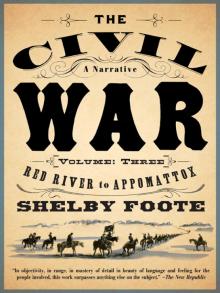 The Civil War: A Narrative: Volume 3: Red River to Appomattox
The Civil War: A Narrative: Volume 3: Red River to Appomattox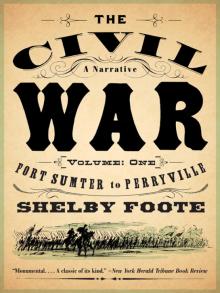 The Civil War: A Narrative: Volume 1: Fort Sumter to Perryville
The Civil War: A Narrative: Volume 1: Fort Sumter to Perryville Jordan County
Jordan County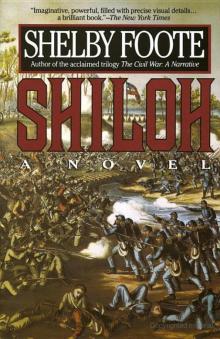 Shiloh
Shiloh Love in a Dry Season
Love in a Dry Season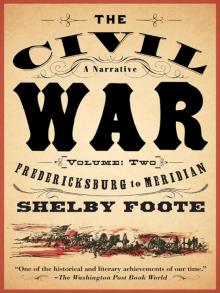 The Civil War: A Narrative: Volume 2: Fredericksburg to Meridian
The Civil War: A Narrative: Volume 2: Fredericksburg to Meridian Chickamauga
Chickamauga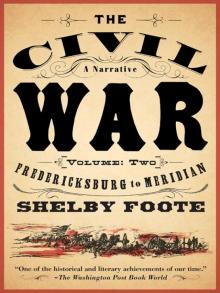 The Civil War: A Narrative: Fredericksburg to Meridian
The Civil War: A Narrative: Fredericksburg to Meridian